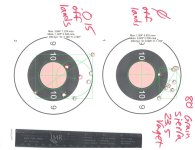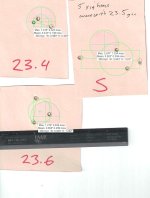Rebs,
Hounddawg is right. If your groups are that size you have more dominant group spread influences than case irregularity and it will be close to impossible to discern any observable difference except perhaps at very long range. If you are using spherical powders, I have been able to measure improved ignition consistency from deburring flash holes in cases that have them (some of the more expensive brands, like Lapua, Norma do not). I have not observed the same effect on stick powders, but it's something I do for long range loads regardless of the powders used.
The reason it is hard to tell is statistical. If you introduce two sources of error, each of which will open a bughole group to 1 moa by itself, most folks assume that means introducing both sources of error at once will open the group 2 moa. It does not. It only opens the group by 1.414 moa (the √2 moa). This is because, when you put two error sources together they only add to one another a small portion of the time. Just as often they subtract from one another. And most of the time the error they introduce isn't in the eact same direction at the same time. In fact, it turns out that, on average, the influences are perpendicular to one another. As a result, the average bullet misses the intended POI by a distance equal to the hypoteneus of a right triangle with 1 moa right angle legs. In other words, it is equal to the square root of the sum of the squares of the two influences taken independently, which in this case is √(1 moa)²+(1 moa)²=√2 moa = 1.414 moa.
So, suppose in the case of a gun shooting a bughole, failing to sort cases opens the group up ¹/₈ moa. To the benchrest shooter that's a noticeable effect. But if my gun shoots one moa normally, then the impact of failing to sort the same cases is the square root of the sum of 1² plus ¹/₈², which comes out to 1.0078 moa. Well, your group sizes change more than 0.0078 moa from one to the next, so how do you tell the tiny influence is even there?
The answer is, again, statistical. The tiny improvement may not be reliably measurable, but if you are in a target shooting discipline, where a hole just scratching the next higher scoring ring gives you the higher score, then, every once in a long while, that tiny difference will give you an extra point. It might only be a couple or three times a season, but it will be there. If you don't shoot targets where a scratch gives you a higher score, then it is hard for me to discern what you are getting out of going to the trouble other than by keeping cases of the same lot with the same load history together, you can tell, when several split at the necks or get head separations, that it is probably time to retire the whole lot.


